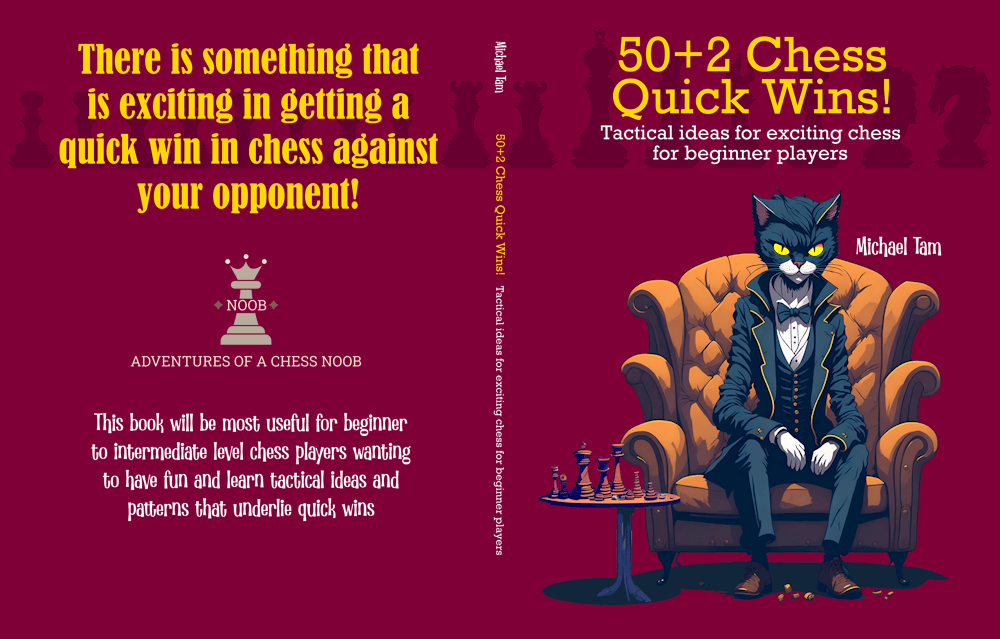
WIN CHESS with the Romantic Style! | Punish BAD Queens! ♟️🤩👍
#tactics #romanticstyle #smithmorra #englund #scandinavian
In my last article, I wrote the following summary:
The big takeaway is that playing in the Romantic style in the opening is not just about relentless aggression. It is the weaving together of opening tactics to take advantage of your opponent’s mistakes and inaccuracies, and taking judicious risk by taking into account psychological factors in choosing moves!
![]()
A conceptual schema in many of the “best opening attacks” in my new book, Become a Chess Assassin!, is:
- Start with a solid opening but choose a line where it is likely that the game will be tactical than positional (for instance, starting with the king’s pawn opening 1. e4 with White).
- Use a probing or provocative move that is tricky for the opponent to navigate. The risk needs to be commensurate with the potential gain.
- When the opponent plays an inaccuracy, strike assertively to capture the initiative, which should hopefully cascade towards a rapid win, or at least, a major advantage out of the opening.
A very common inaccuracy in the opening, especially at the beginner-intermediate level, is an early queen move. Now, there are opening lines where an early queen attack is accurate, or part of well understood theory. However, it can often be difficult to find the accurate queen moves, especially when the queen comes under attack by pawns and other less valuable pieces.
I’ve recently played three unrated games against Random Noob that demonstrate this well. From the perspective of playing in the Romantic style in the opening, the tactical notion is that one must punish the opponent for their early queen move immediately. A slower more positional approach might gift the opponent just enough time to consolidate, which then justifies their queen development to our detriment. Counterattacking our opponent’s intemperate queen often allows us to win tempo and developmental advantage, which becomes a fertile ground for setting up a beautiful winning combination!
![]()
Game 1: Sicilian Defense: Smith-Morra Gambit Queen Trap!
https://www.chess.com/analysis/library/kUeHV7qyQ
In the first game, I had the White pieces, Black plays the Sicilian Defense, and it was clear that they didn’t know how to respond the Smith-Morra Gambit, declining it with (2… Nc6). This is a mistake as Black’s knight can immediately be attacked by d5. However, just like in the game with ProfessorJ in my last article who made a similar move, sometimes one can launch a more powerful attack by taking a calculated risk to develop a piece first, before striking forth against a minor piece. This worked as (3. Nf3!? d5 4. exd5! Qxd5 5. Nc3!): I’d baited Black’s queen to develop to the centre of the board, and now started a series of attacks on Black’s queen with development!
On turn 5, Black plays (5… Qe6+?!), a move that doesn’t obviously look bad, but as we’ll see a powerful tactic suddenly becomes available for White. Simply, if I could get a knight onto the c7 square, it would be a family fork!

![]()
In the following few turns, I force/encourage some trades in the centre, develop my own queen, and with (9. Nd5), I’m threatening to make good Nc7+! Black recognises the tactic, but that doesn’t mean it is necessarily easy to navigate. They found (9… Qc6?), which makes sense. The queen defends the c7 square and counterattacks my c2-pawn. Danger averted right? NO! 🤩
I now had the brilliant move (10. Bb5!!), directly attacking the queen with a seemingly sacrificial move. However, if Black captures the “hanging” bishop with (10… Qxb5??), then once again Nc7+ would be a family fork!

![]()
More than that, there was a second layer to this attack. Again, Black saw the tactic, but probably thought that there were no problems as they could move their queen out of the attack with (10… Qxc2), winning my c-pawn. However, this was a blunder, and they didn’t see that their queen was going to be lost in a number of ways!
Turn 11, I capture Black’s bishop with check (11. Bxd7+) and Black’s best response is to accept that their queen is lost by capturing back the bishop (11… Kxd7) and allowing (12. Nb4+): the knight move reveals a discovered check, and the knight attacks Black’s queen on c2!
Black avoided the capture, having calculated the imminent loss of their queen and sidestepped with (11… Kd8?!), an understandable move, but to no avail as (12. Ba4!?), and I once again force Black to respond to an attack on their queen. The curious thing is that Black’s queen is basically trapped. Any move of their queen would result in some version of a knight move with discovered check and an attack on their queen! In the game, they ran their queen (12… Qf5??) which is [+M5]. I capture Black’s queen, and then with my queen and bishop pair, pluck Black’s king from the back rank, corral him to the a-file, and deliver checkmate. Good game, GG!
![]()
Game 2: Recovering from a mouse-slip in the Englund Gambit!
https://www.chess.com/analysis/library/Mirt13o7t
I had the Black pieces and play the Englund Gambit against White’s Queen’s Pawn Opening, which was Accepted (1. d4 e5 2. dxe5) and then “mouse-slip” (2… c6?)! Now, this wasn’t exactly a mouse-slip per se as I was playing on my tablet and had careless dragged the c-pawn rather than my b8-knight to the c6 square with my finger. I’m sure you get my point!
So, what to do? The way to consider this is that it’s like I lost a step of tempo while trying to play into the Englund Complex position. Nonetheless, building up an attack on White’s advanced e5-pawn in the centre is still the best approach, and this worked! On turn 7, I’d coaxed White to play the inaccurate and intemperate (7. Qd4?!) to which I could respond with (7… c5!?), counterattacking White’s queen while there was tension in the centre of the board.
White moved the queen (8. Qe4??), it looks okay but it’s a blunder as White’s e5-bishop is pinned. However, I don’t play the most accurate (8… f6) which wins the bishop but make a calculated risk to once again hit White’s queen with development and tempo (8… Ngf6!?). White moves their queen yet again, and another mistake (9. Qf5?).
And here, I had a nice tactic with (9… Nxe5!?), a double attack: my e5-knight attacked White’s f3-knight, and the knight move revealed my light square c8-bishop with an attack on White’s queen. White’s eye was drawn to the e5-knight as it appeared that they could win my knight for “free” as they had two attackers on the e5 square while I only had a single defender. After thinking for 13.8 seconds, they captured (10. Nxe5??) and hung their queen (10… Bxf5!). Keep an eye on those diagonals!

![]()
The remainder of the game proceeded smoothly. I force a trade of pieces, and castle my king out of the centre. However, on turn 16, I find a delicious Romantic finisher with (16… Bc5!!). Having already seen the tactic, I snapped moved my bishop, seemingly hanging my queen on b4, “oh no, my queen!”. White is unable to resist and captures the poisoned queen (17. axb4??) and falls to a beautiful checkmate combination with (17… Bxf2#)!

![]()
![]()
Game 3: Crushing the inaccurate Scandinavian Defense!
https://www.chess.com/analysis/library/4NghDSbASi
I had the white pieces in this game and Black played the Scandinavian Defense, one of the openings where an early queen move (1. e4 d5 2. exd5 Qxd5) is completely fine. However, after (3. Nc3), Black must play accurately. The historical Valencian Variation, the oldest opening with the black pieces described in Scachs d’amor from 1475, is to retreat the queen (3… Qd8). This was favoured by Joseph Blackburne, one of the two chess masters who developed the modern opening theory of the Scandinavian Defense. Jacques Mieses preferred to keep the queen active with (3… Qa5), and this is now considered the Main Line.
Commonly at the beginner-intermediate level, Black will now make a mistake and in this game, this was (3… Qe5+), and after blocking the check with the bishop (4. Be2), we can start hunting Black’s queen with development (5. Nf3)!
On turn 6, Black un-developed the queen after all (6… Qd8), but consider, four of the first six moves were queen moves, and the queen is back on her throne!

![]()
This now gave me significant latitude and my approach was simple. I castle my king to safety and then probe and poke at Black’s position looking for tactical possibilities. For instance, (8. Bf4) was potentially setting up an attack on Black’s c7-pawn; (10. Rb1) and (11. Re1) activated my rooks to control the two semi-opened files; (12. Bb5+!?) was to lure Black to play (12… c6?!) and undermine their fianchetto b7-bishop; and (14. Bg5) to pin Black’s knight to their queen.
Finally, with (17. Qf3!?), Black misses the attack on their a8-rook along the long light square diagonal. Keep an eye on those diagonals! After (18. Qxa8!) and (19. Nc6), I had a powerful attack on Black’s king. They stumble, possibly under-calculating and under-recognising the squares controlled by the combination of queen and knight, and blunder [+M2]. Good game, GG!
![]()




